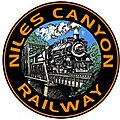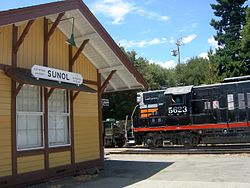Construction
The Pacific Railroad Act of 1862 authorized the Central Pacific Railroad and the Union Pacific Railroad to build the transcontinental railroad between the Missouri River and the waters of the Pacific. For various reasons, the Central Pacific Railroad reached an agreement with the first Western Pacific Railroad (1862-1870) (not related to the later company of same name) to build the westernmost portion of the line connecting the Central Pacific in Sacramento to San Jose via Stockton and Livermore. Trains could then continue to San Francisco via the San Francisco & San Jose Rail Road which was completed in 1864.
By 1866, the Western Pacific had built 20 miles (32 km) of track north and east from San Jose, reaching halfway into what was then known as Alameda Cañon, to about Farwell near milepost 33. [2] The Western Pacific used 500 Chinese laborers to grade and construct the rail line into the rugged canyon with its tight curves and narrow banks. Construction was then halted because of disagreements between the railroad's contractors and its financiers.
In 1869, the Central Pacific Railroad, a subsidiary of which had acquired the Western Pacific and Oakland Point in 1868, restarted work on the railroad line through Alameda Cañon in two opposite directions, both using Chinese laborers. In June 1869, J. H. Strobridge and crew began to lay out a new line starting at a point on the 1866 Western Pacific rails in the west end of Alameda Cañon (San Jose Junction at MP 30.6) westward out of the canyon towards Oakland, while Turton, Knox & Ryan dispatched workers to continue the railroad in Alameda Cañon eastward from the point where the 1866 Western Pacific rails abruptly stopped. [3] [4] Four major timber through (Howe) truss bridges were built to cross Alameda Creek and Arroyo de la Laguna Creek. In addition to building wooden bridges and grading the railroad bed, the laborers built culverts, retaining walls, and bridge piers in masonry. [5] By mid-August 1869, the railroad was completed through Alameda Cañon eastward to Pleasanton and into Livermore Valley. [6] [7]
In September 1869, the railroad from Sacramento through Alameda Cañon to the waterfront Alameda Terminal at San Francisco Bay was completed. According to the Daily Alta California, the first Western Pacific train ran from Sacramento through the canyon on September 6, 1869, to a cheering crowd at Alameda Terminal, while a few cars switched off at the San Jose Junction for San Jose and Gilroy. [8] This opening of a transcontinental railroad to the Pacific coast, as envisioned by the 1862 Pacific Railroad Act, came four months after the Central Pacific and Union Pacific met at Promontory Summit, Utah. On November 8, 1869, the intended western terminus opened at the Oakland Long Wharf, from which ferries connected to San Francisco. These ferries continued to be the final link for passengers to San Francisco until 1958.
At the mouth of Alameda Cañon was Vallejo Mills and the San Jose Junction (MP 30.6) was located about a mile east, inside the narrow confines of the cañon. In 1870 a connector was built just west of Vallejo Mills on the 1869 Central Pacific line to Oakland, connecting it to the original 1866 Western Pacific line to San Jose. At the junction (MP 29.2) in the valley, Central Pacific added a roundhouse and a train depot, complete with a restaurant and saloon for the convenience of the train passengers transferring there. [9] Meanwhile, in 1869 Central Pacific renamed the station for their railroad attorney and stockholder, Addison Niles, who later became associate justice on the California Supreme Court. Shortly thereafter, the Vallejo Mills settlement around MP 29.2 became known as Niles, which has become since 1956 a district within the city of Fremont. Likewise, Alameda Cañon thereafter became known as Niles Canyon. [10]
Railroad use
When built, the rail line through Niles Canyon was the primary route for overland traffic to and from the San Francisco Bay. A shorter rail line between Oakland and Sacramento was established via the California Pacific Railroad and a train ferry at Benicia by 1879. As a result, the original line became less used due to its longer route and its steep grade over Livermore Pass (known today as Altamont Pass). Passenger and freight trains on the line was reduced to local service only. This secondary status was maintained until the early 20th century when the Southern Pacific Railroad (successor to the Central Pacific) came under the leadership of E. H. Harriman. Freight traffic in and out of San Francisco had become too heavy for the ferries across the bay and across the Carquinez Strait to handle. An all land route via San Jose and Niles Canyon was available, but was overly circuitous. Several major capital improvement projects undertaken during this era, including the completion of the Coast Line and the construction of the Dumbarton Bridge, revitalized the original line through Niles Canyon. Steel bridges replaced the covered timber bridges at Farwell and Dresser and the small railroad town of Niles became an important junction as freight from the San Francisco Peninsula and produce from the Santa Clara and Salinas Valleys traveled through the canyon to points east. Despite these improvements, the few rebuilding programs by the railroad left the Niles Canyon line with many of its original cut-stone bridge abutments, culverts, and retaining walls from the Western Pacific's original right of way. Many of these stonework built by Chinese laborers in the late 1860s can still be seen today. [2] : 87
Preservation
The decline in San Francisco's status as a port with the advent of containerization, [11] combined with the movement of produce traffic to the highways once again left the railroad through Niles Canyon with little business. Southern Pacific ceased its operations through the canyon in 1984, and deeded the land to Alameda County; the portion over Altamont Pass was briefly reopened in 1985 for "scab trains" to train management crews ahead of a possible union strike. [12] Commercial rail operations through Niles Canyon now operate on a newer line, which is owned by Union Pacific (formerly Western Pacific) and also used by the Altamont Corridor Express (ACE) commuter train.
The Pacific Locomotive Association leased the right of way from the county and began working to reconstruct the track in 1987. The Niles Canyon Railway ran its first passenger train from Sunol on May 21, 1988. Passenger trains once again connected Sunol and Niles starting on April 9, 2006. The organization continues its work to extend and maintain the track along the line; restore its collection of railroad equipment; and operate historic demonstration trains for the benefit of the public. They plan to eventually extend their demonstration train service to Pleasanton, California.






























